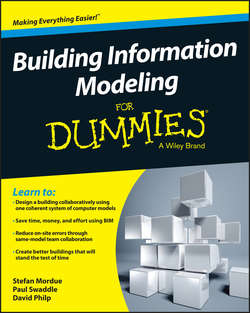Читать книгу Building Information Modeling For Dummies - Swaddle Paul - Страница 7
На сайте Литреса книга снята с продажи.
Part I
Getting Started with Building Information Modeling
Chapter 1
Defining Building Information Modeling (BIM)
Understanding the Requirements for BIM
ОглавлениеHere’s a list of what you really need for BIM implementation to thrive:
✔ Digitization: You have to be confident that the future of the industry is digital. Think about how technology has evolved in most industries and how in your experience of the construction industry you may have noticed that it’s still traditional and paper-based. BIM implementation requires a change of direction, toward new tools and software and a digital future.
✔ The right foundations: In order to build advanced BIM processes, you need the firm bedrock of efficient systems for communication, information exchange, and data transfer. Think about what practical changes you may require and even the type of projects you focus on. We show you how you can describe your BIM readiness in terms of levels of maturity. Chapter 7 discusses the importance of having a foundation before you implement BIM.
✔ Process: What’s wrong with what you’re already doing? We hope you can see where you can make improvements in your current processes, and that moving toward BIM implementation should have a positive effect on your business. Some essential elements to collaboration exist, and in Chapter 8 we show you an example of best-practice work flow and an explanation of some of the key acronyms you’ll encounter.
✔ Technology: You need to ensure that you have the right technology to support your BIM aims and objectives. Technology includes software and hardware. Having the right technology enables you to work in a digital environment. In Chapter 21, we show you different types of BIM platforms and software, with some important examples and discussion points for when you have to make decisions.
✔ Training: All the processes, frameworks, and documents in the world won’t help if people don’t understand them and can’t use the tools and methods you’re implementing. So a key requirement is to support all the technology and protocols with dedicated and personal training. We point you towards some great resources you can look to for help in Chapter 22.
✔ Incentives and business drivers: Incentives are what motivates and encourages you and your organization to undertake BIM, whereas your business drivers refer to processes that are vital for the continued success and growth of your business. Some business drivers may be outside business drivers; for example, economic conditions that a company can’t always influence. The UK is mandating BIM from 2016, and the United States, although still behind, demonstrates huge potential for standardization. In Chapter 9, you can read about the UK Government Construction Strategy and where the BIM mandates came from, and compare it with BIM uptake in the United States and across the rest of the globe.
✔ Standardization: For BIM to thrive, you need interoperability. Interoperability is a term that’s important in BIM-speak. Interoperability is ensuring that you can use the outputs someone else in the project team has produced, because you’re all using standard formats. Other BIM standards exist, along with a range of recommended protocols, guidelines, and specifications for the properties of objects you use in your models in the form of information exchanges. In Chapter 9, we help you navigate through these documents and show you how everything could evolve.
A very brief history of BIM
Even though there’s been a recent push to implement BIM and a realization of its benefits, BIM isn’t a new concept. The earliest use of the term building modeling was in the 1980s, in a paper that predicted that model objects would connect to relational databases full of different kinds of information. And long before that, college research teams were developing computer modeling techniques with buildings in mind. Even just on the graphical side, university research has had a significant impact on modeling advances.
Software companies have been developing tools for built environment professionals to design, plan, render, and analyze buildings and structures for decades. Although most have focused on 3D geometric modeling systems, the largest platforms have been exploring how to make the most of data science and the properties of building products too. The first use of the term BIM to describe all this goes back as far as the 1990s. The awareness, investment, and supporting documentation have all increased dramatically in the past few years, though.
For more information on the history and theories of BIM, we suggest that you check out some great books by the fathers and godfathers of BIM such as The BIM Handbook by Chuck Eastman, Paul Teicholz, Rafael Sacks, and Kathleen Liston (John Wiley & Sons, Inc.) and Building Information Modeling: BIM in Current and Future Practice by Karen Kensek and Douglas Noble (John Wiley & Sons, Inc.).
